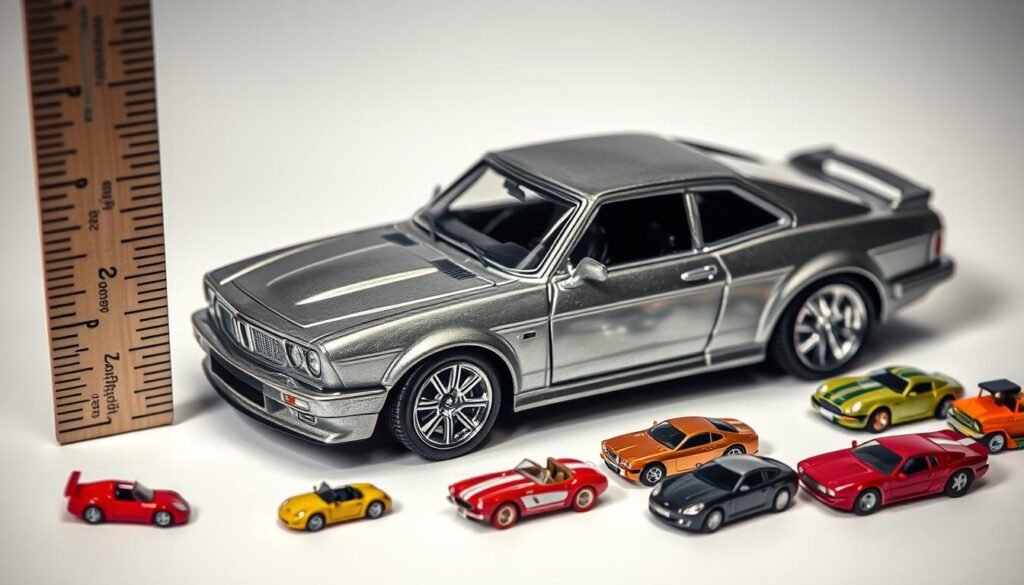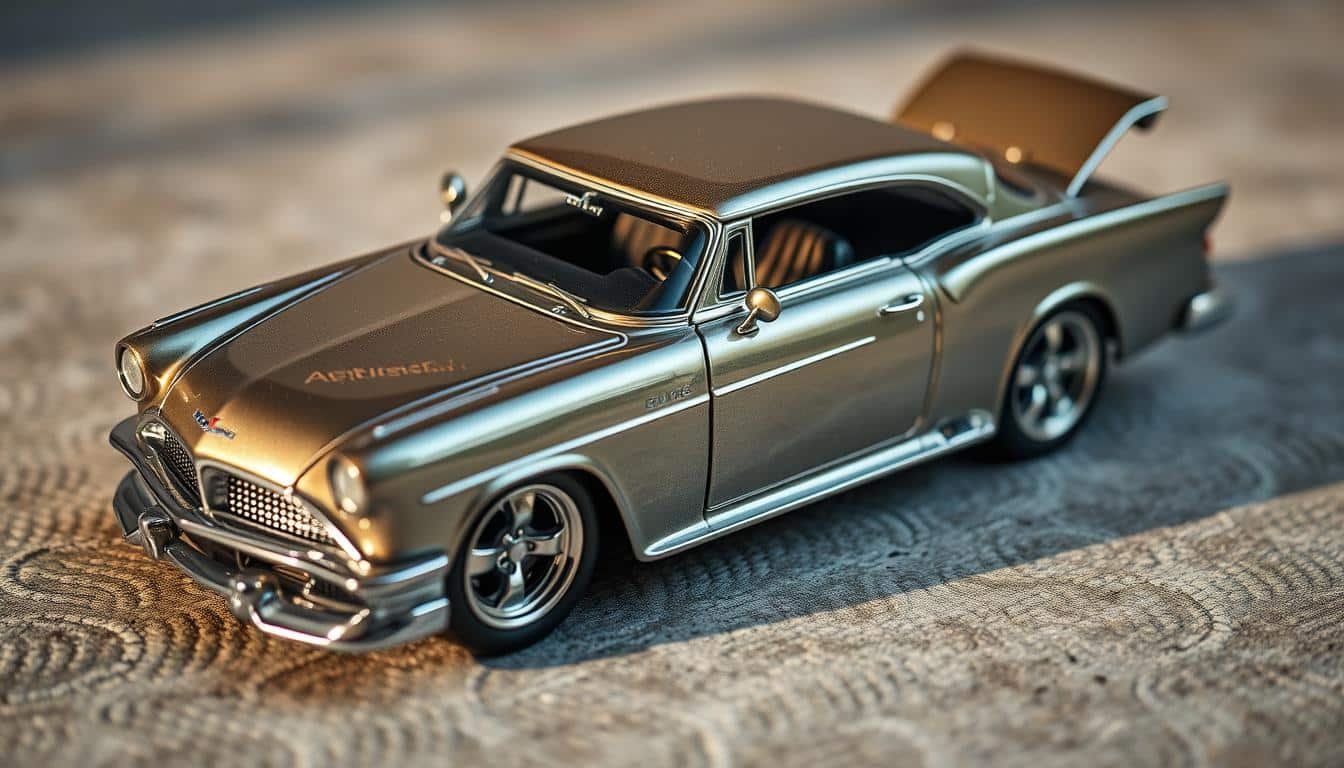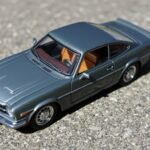Ever wondered how big a 1:18 scale diecast car really is? Knowing the size and scale of these tiny models is crucial. It helps us appreciate their detail and find the perfect spot to show them off. So, just how big is a 1:18 diecast car, and how does it stack up against other scales? Let’s explore the world of diecast model sizes together.
Key Takeaways
- 1:18 scale diecast cars usually range from 8 to 11 inches (18 to 20 cm) long
- Diecast scale shows how a model compares to the real car
- Model size changes based on the car’s size, with bigger scales showing more detail
- In the US, 1:18 scale is a favorite for its size and price
- Knowing about diecast scales helps collectors pick the best models for their collection and display
Understanding Diecast Scale Measurements and Ratios
Diecast car models have scale measurements and ratios that are key. These numbers show how big the model is compared to the real car. For example, a 1:18 scale model is one-eighteenth the size of the actual car.
What Scale Numbers Mean
The scale number shows the model’s size compared to the real car. In the hobby car model world, you’ll see:
- 1:12 scale
- 1:18 scale
- 1:24 scale
- 1:32 scale
- 1:43 scale
- 1:64 scale
Common Scale Ratios Explained
Big scale numbers like 1:12 and 1:18 mean bigger models with lots of details. These are favorites among serious collectors. Smaller numbers like 1:32 and 1:64 make for smaller, more affordable models. They’re great for display or casual play.
How Scale Affects Model Size
The scale of a model car changes its size. For example, a 12-foot car would be about 8 inches long in 1:18 18 scale replica sizes. The scale decides how big the model is and how much detail it has. This lets collectors choose based on their preferences and how they plan to use the hobby car model proportions.
How Big Is a 1 18 Diecast Car: Detailed Size Breakdown
The 1:18 scale is a favorite among car enthusiasts. These models are between 9 and 12 inches long. This length depends on the size of the real car they’re based on.
For example, a 4.3-meter car becomes about 24 cm (9.4 inches) long in 1:18 scale. This size is perfect for showing off detailed models. It’s why many collectors love these miniatures.
The size of a 1:18 diecast car can change a bit. This depends on the car model being made. But, this size range gives a good idea of what to expect from these models.
| Scale | Length | Width | Height | Price Range |
|---|---|---|---|---|
| 1:12 | 14.5 inches | 5.5 inches | 4 – 4.5 inches | $300 – $700 |
| 1:18 | 9.5 inches | 4 inches | 3 inches | $150 – $300 |
| 1:43 | 4.75 inches | 1.75 inches | 1 inch | $100 – $150 |
| 1:64 | 2.75 inches | 1 inch | 0.75 inch | $15 – $40 |
The table shows that 1:18 scale cars are just right. They’re big enough to be impressive but small enough to fit on a shelf. This makes them a top pick for car model fans.
Popular Diecast Scales and Their Applications

In the world of diecast model collecting, the scale of the car is key. It determines the size, detail, and appeal of the model. Popular scales include 1:12, 1:18, 1:24, 1:43, and 1:64. Each scale meets different collector preferences.
Collector Preferences by Scale
The 1:18 scale is a favorite for many. It balances detail and size well. These models have over 180 parts, making them very realistic.
The 1:64 scale is great for those with little space. It’s affordable and allows for big collections without taking up much room.
Display Considerations for Different Scales
Scale choice affects how you display and store your models. Larger scales like 1:12 and 1:18 need more space. But, they show off details better.
Smaller scales, like 1:43 and 1:64, are more compact. They’re perfect for small display areas.
Market Trends in Scale Selection
Lately, the 1:64 scale is becoming more popular. It’s affordable and saves space. But, the 1:18 scale is still loved by high-end collectors. They value its craftsmanship and detail.
As the diecast market grows, we’ll see more scales. This will cater to all collector preferences.
| Scale Ratio | Typical Part Count | Material Used | Retail Price Range |
|---|---|---|---|
| 1:12 | 200+ | Plastic, Alloy, Metal | $100-$500 |
| 1:18 | 180+ | Plastic, Alloy, Metal | $50-$300 |
| 1:24 | 100-150 | Plastic, Die-cast | $30-$150 |
| 1:43 | 80-100 | Die-cast | $20-$100 |
| 1:64 | 50-80 | Die-cast | $10-$50 |
Diecast model fans have many options, from 1:12 to 1:64. The market caters to all collecting tastes and display needs.
Conclusion
Diecast model cars range from tiny 1/64 sizes to large 1/18 scales. Each size has its own benefits and things to think about for collectors. The 1:18 scale, about 9-12 inches, is loved for its size and detail.
Knowing about different scales helps when you’re adding to your diecast car collection. Things like what you like, how much space you have, and how detailed you want them matter. These factors help pick the best scale for you.
If you love diecast model cars, learning about scales makes them even more special. The right scale lets you show off the beauty and skill in your collection. It’s all about finding the perfect fit for your collection.
FAQ
What is the size of a 1/18 scale diecast car?
How are diecast model sizes expressed?
How does scale affect the size of a diecast model?
What are the common diecast scale ratios?
How do collectors and enthusiasts choose the right diecast scale?
Source Links
- Awesome Diecast – Diecast Model Replica Cars, Trucks, Buses and More – https://www.awesomediecast.com/choosing-right-scale/
- Size, Scale and Price Comparison Explained for Die-cast and Resin Model Cars – https://www.modelcarshouston.com/blogs/news/size-scale-and-price-comparison-explained-for-die-cast-and-resin-model-cars?srsltid=AfmBOoopqthb5pMU0cjfFAuSS1yj_JP4L2O0pT8lip_B0zfsKU1kIYmi
- Scales & Sizes – https://diecastmodelcentre.co.uk/pages/size-guide?srsltid=AfmBOoq2qAYL6uBIplV33tI5RWn0bdBqsC0abBAWVxrtpAX1yfxpjdTE
- Understanding Scale Sizes & Gauges for Diecast Models, Slot Cars, Toy Trains, Airplanes & Beyond – https://www.onallcylinders.com/2023/11/09/understanding-scale-sizes-gauges-for-diecast-models-slot-cars-trains-airplanes-beyond/
- Scales & Sizes – https://diecastmodelcentre.co.uk/pages/size-guide?srsltid=AfmBOoobEwAsyLSkw34zCIdJG67i153mVFK2wxEEvozMCsCHbKgzi7ZH
- Dimensions, Prices & Best Scale Ranking – https://www.diecasting-mould.com/news/diecast-car-scale-size-guide-dimensions-prices-best-scale-ranking
- Size, Scale and Price Comparison Explained for Die-cast and Resin Model Cars – https://www.modelcarshouston.com/blogs/news/size-scale-and-price-comparison-explained-for-die-cast-and-resin-model-cars?srsltid=AfmBOoqh_VV-TbukXPdb23X_AeRyVFdPBRN_icejInxcNADGsLrJ8_GB
- No title found – https://www.aliexpress.com/w/wholesale-1-18-diecast-model-cars.html
- Sizes By Scale 1:18 Scale – https://www.abovetoys.com.au/sizes/by-scale/1-18-scale/
- Which brand of diecast model cars is better? How to judge the quality of diecast model cars? – https://www.paudimodel.com/which-brand-of-diecast-model-cars-is-better/
- Size Matters: The Size Guide Of Diecast Car Models – https://www.tinytown.in/blogs/news/diecast-car-models-size-guide?srsltid=AfmBOorDQ-F7346n34rmRwjE1AeoAhl2csCmPihg9eQrT0oEJBnseGX1
- Understanding the Dimensions: What Size is a 1:18 Scale Model Car? – https://www.model-car-world.co.uk/blog/post/Understanding the Dimensions: What Size is a 1:18 Scale Model Car








Interesting read but isnt the true essence of diecast collecting the artistry and detail, not just the size and scale ratios?
Artistry and detail matter, sure, but size and scale bring realism to diecast collecting. Its not just about aesthetics!
Interesting read, but why is 1:12 scale overlooked? Arent bigger, detailed models more exciting for collectors? Lets talk about this, guys.